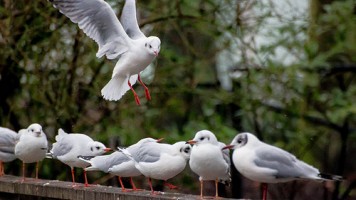 In April, Nina Simon furthered the conversation about the nature of community and the means of engagement. Her posts, How Do You Define “Community”? and Building Community: Who/How/Why? were invaluable additions to the field. As is often the case, I could be perfectly happy with providing those links and ending this post. However, I don’t want to feel like a total slacker, so let me add a word or two regardless of whether or not there is a need to do so.
In April, Nina Simon furthered the conversation about the nature of community and the means of engagement. Her posts, How Do You Define “Community”? and Building Community: Who/How/Why? were invaluable additions to the field. As is often the case, I could be perfectly happy with providing those links and ending this post. However, I don’t want to feel like a total slacker, so let me add a word or two regardless of whether or not there is a need to do so.
In the first post, Ms. Simon’s understanding of community, as mine–see below–is an evolving concept. I was particularly taken with her articulation of three concepts that can create a community: geography (place), identity (attributes), and affinity (preferences/likes). She acknowledges these as preliminary categories and even in her responses to comments she entertained additional ones.
For some time I have been using a ridiculously simplistic definition of community: groups of people with something in common. I’ve even been known to say that the people do not need to self-identify as having anything in common. Clearly, this is not a definition that has any value for a sociological understanding of community and its benefits. It is solely a tool for arts organizations to use in identifying those groups with which to engage. (Many millennials do not see themselves as a community, for instance.) One thing Ms. Simon and I have in common around this is the need for arts organizations to be intentional about selecting communities with which to engage. They must then set about to build relationships with those they choose.
Ms. Simon’s second post addressed the how and why of engagement. Again, I like her labeling of three kinds of “how’s”: individual empowerment, social bonding, and social bridging. (The latter two are sometimes referred to bonding social capital and bridging social capital.) She acknowledges that bridging (fostering relationships across lines of difference) is the most difficult of the three and the one requiring the greatest thought in planning.
But to me the most exciting part of that post addressed the question of “Why?” Effective community engagement must grow out of a commitment to a purpose larger than the well-being of the arts organization. I often say community engagement must be beneficial both to the organization and to the community. If it’s only about the organization, why would any community member be interested? The Santa Cruz Museum of Art and History seeks “to build a stronger and more connected community.” Doing so, they’ve benefited themselves, to be sure, but Santa Cruz as well. But Ms. Simon does not see that as necessary or even desirable for every museum. She said that what’s important is “being authentic to what your institution is about, the community you work with, the vision you have.” That vision of something larger is what energizes her staff. It can also motivate a community to partner with an arts organization. She concluded her post with the following:
I don’t care what important problem you choose. But I hope you are working on one. Important problems will keep you up late at night, but they’ll also get you out of bed in the morning. They are the reason this work matters.
It is intentionality about outcomes important to a community that create the excitement to sustain engagement work over the long haul. An organization’s demonstrable commitment to “doing good” in a community will translate into enthusiasm for its work among those with whom we are attempting to engage.
Engage!
Doug
Photo:![]()
![]() Some rights reserved by Infomastern
Some rights reserved by Infomastern
